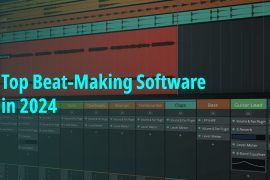Integrated Development Environment, or IDEs, are software platforms that combine a full range of tools for software development into a single package for programmers and developers. IDEs are designed to integrate with certain application platforms and remove hurdles in the software development lifecycle. In development teams, IDEs are used to create new software, apps, web pages, and services, and they aid by providing a single tool with all of the functionality and eliminating the need for integrations. IDEs are used to design code for a certain platform or platforms, and they have built-in features that know how the platform works and how to use its features via compiling, debugging, or intelligently completing code.
Table of Contents
Criteria for Integrated Development Environment

- Provide programming skills via a text editor or a graphical user interface (graphical user interface)
- At least one platform must be integrated without the use of a separate plugin.
- Allow compiling, debugging, version control, platform-specific code suggestions, and code deployment via a platform’s application programming interface (API).
Choosing the best Online Integrated Development Environment (IDE) can often be a difficult task. But worry not, we are here to help. Given below is a list of the most suitable Online Integrated Development Environment (IDE) for businesses and individuals to help you decide on the best one for your needs.
Top 8 Online Integrated Development Environment
Visual Studio IDE
Microsoft Visual Studio is an Integrated Development Environment (IDE) developed by Microsoft for several types of software development, including computer programs, websites, web apps, online services, and mobile apps. Completion tools, compilers, and other capabilities are included to make the software development process easier. Visual Studio is a software development tool that has been available for more than two decades. Visual Studio 97 was the initial version. Since then, many new versions have been released, the most recent of which is Microsoft Visual Studio 2019.
The Visual Studio IDE (Integrated Development Environment) is a piece of software that allows programmers to write and edit code. Its user interface is used to edit, debug, and build code in software development. Visual Studio comes with a code editor that supports IntelliSense (code completion) and code refactoring. The integrated debugger can be used as both a source-level and a machine-level debugger. A code profiler, a designer for creating GUI applications, a web designer, a class designer, and a database schema designer are among the other built-in tools.
Eclipse Che
Eclipse Che is an Integrated Development Environment (IDE) and workspace that runs on the web. In Eclipse Che, workspaces are packaged with a proper runtime stack and their own Integrated Development Environment (IDE), all in one tightly integrated package. A project in one of these workspaces has everything it needs to run without requiring the developer to do anything other than select the appropriate stack when creating the workspace.
Eclipse Che comes with ready-to-use packed stacks that span the majority of today’s popular languages. C++, Java, Go, PHP, Python,.NET, Node.js, Ruby on Rails, and Android development stacks are available. A Stack Library gives you even more options, and if that’s not enough, you can construct your own custom stack to create specific situations. Eclipse Che is a full-featured Integrated Development Environment (IDE), not a basic web-based text editor. It is based on Orion as well as the JDT. Intellisense and debugging are both available, and Git and Subversion version control are incorporated. For partnered programming, the IDE can even be shared by numerous people. A developer can write and debug code using only a web browser.
CodePen
CodePen is an online social development platform with a built-in code editor for building, testing, and discovering HTML, CSS, and JS code. CodePen is a collaborative development platform. Its core functionality is that it allows you to write code in the browser and view the results as you go. A powerful and liberating online code editor for developers of all skill levels, but especially for those learning to code. CodePen is a code editor and social community platform for front-end designers and developers that allows users to build and launch websites, exchange code, and learn and discover code from over 1.8 million front-end designers and developers.
Users may develop and deploy HTML, CSS, and JavaScript code for any project, as well as isolate test cases to learn and debug, using Codepen’s integrated front-end code editor. For teams, many users can update code at the same time and collaborate on any project using built-in chat capabilities. Drag-and-drop uploads, live previews, autocomplete, website deployment, and more are all available in CodePen’s IDE.
IntelliJ IDEA
IntelliJ IDEA is a Java-based Integrated Development Environment (IDE) that aims to boost developer productivity. It takes care of the mundane and repetitive duties for you by providing intelligent code completion, static code analysis, and refactorings, allowing you to concentrate on the more pleasurable aspects of software development.
Every component of IntelliJ IDEA is designed to offer you a smooth experience right out of the box. It gives you rapid access to all of the functionality and integrated tools that you need for your job, as well as a variety of customization possibilities. Everything may be fine-tuned to complement your workflow: create shortcuts, install plugins, personalize the interface, and more. Modern application development necessitates the use of a variety of languages, tools, frameworks, and technologies. Although IntelliJ IDEA is built as an IDE for JVM languages, it can be extended with a variety of plugins to provide a polyglot experience. Most IntelliJ platform-based IDEs are superseded by IntelliJ IDEA Ultimate. When the bundled language plugins are activated, all technologies accessible in our more particular IDEs, such as PyCharm, WebStorm, PHPStorm, and so on, are supported.
AWS Cloud9
AWS Cloud9 is a browser-based Integrated Development Environment (IDE) that allows you to write, run, and debug code. A code editor, debugger, and terminal are all included. Cloud9 is pre-installed with key tools for major programming languages such as JavaScript, Python, PHP, and more, so you don’t have to install files or set up your development workstation to get started. Because your Cloud9 IDE is cloud-based, you may work on your projects from any internet-connected machine, including your office, home, or anyplace else. Cloud9 also offers a smooth development experience for serverless apps, allowing you to simply define resources, debug, and switch between local and remote execution.
You can share your development environment with your team fast with Cloud9, allowing you to pair programs and track each other’s inputs in real-time. You can build, execute, and debug programs using only a browser, rather than installing and maintaining a local IDE. Code hinting, code completion, and step-through debugging are among the time-saving features included in the Cloud9 code editor and an integrated debugger. The Cloud9 terminal is a browser-based shell that allows you to install additional applications, publish changes to Github, and run commands.
Codeanywhere
Codeanywhere is a cloud-based Integrated Development Environment (IDE) with a built-in code editor, a full-featured development environment for servers and containers, a built-in debugger, and live collaboration capabilities. Intelligent editing capabilities such as auto-completion, advanced refactoring, linter inspection, and code formatting are included in Codeanywhere. All major programming languages, including Javascript, Python, Java, C++/C, C#, Ruby, and others, are supported by Codeanywhere. Users can join servers using any common protocol and modify files directly on any server using the SSH web-based interface for server management. The web-based terminal for Codeanywhere allows you to run Git commands, debug running applications, preview app output, and building code. Users can also collaborate on any project utilizing Codeanywhere’s pair programming or live terminal sessions. Any project can be shared in real-time with other software engineers.
Codeanywhere is a cloud-based IDE with all of the functionality of a desktop IDE. Codeanywhere is incredibly flexible, allowing you to set up your workflow in whatever manner you want it, thanks to additional advances that only a cloud application can provide.
CodeSandbox
CodeSandbox is a web application development environment that can be accessed through a browser. There is no need for setup, so you can get started right away. Sandboxes can simply be shared with teams or coworkers, and as many as are needed can be created. Codes are immediately performed while using the live updates functionality, allowing you to witness outcomes in the sandbox. GitHub can be used to link sandboxes. Official templates for Vue, Angular, React, Next, and Apollo is provided, allowing users to jump right into any new project. You can utilize pre-made community templates or create your own. Vercel and Netlify are two development tools that CodeSandbox connects with. GitHub can be used to sync sandboxes. Standard actions are made faster via key bindings and Quick Action routines.
Containers can be used, and frontend and backend applications can be created. A terminal incorporated inside the editor is used to run scripts and commands. Additionally, CodeSandbox provides both public and private sandboxes. Sandboxes can be downloaded in a compressed format and worked on your own computer.
Koding
Koding is a feature-rich cloud-based development environment that includes free virtual machines, an appealing IDE, and sudo level terminal access! Collaborate and develop in the cloud with no software to install on your computer. You’ll be up and running on your own cloud-based Linux systems in minutes, learning programming languages such as Ruby, Go, Java, NodeJS, PHP, C, C++, Perl, Python, and more! Koding is a modern development environment that allows developers and team managers to collaborate on projects in the cloud, optimizing development workflows. Koding is ideal for enterprises with large teams since it allows users to share development environments in real-time without having to deal with cumbersome setups.
Developers can use Koding’s browser-based IDE and terminal to code online, or they can use their own IDE, code editor, and terminal. As a result, they won’t have to give up their favorite development tools. Koding also provides access to comprehensive analytics, allowing teams and developers to identify bottlenecks and inefficiencies in their workflows and procedures.
Conclusion
Projects can be accessed from anywhere in the Online Integrated Development Environment; no specific settings or configurations are necessary. Because all data is saved in the cloud, there are no hardware limitations. Internet is required; however, because it is rendered through the internet, it is slower than offline IDEs. Online IDEs offer fully configured developer workspaces with a favored IDE and environmental settings specific to a particular production environment. Configuration drift is not a problem with online IDEs.






